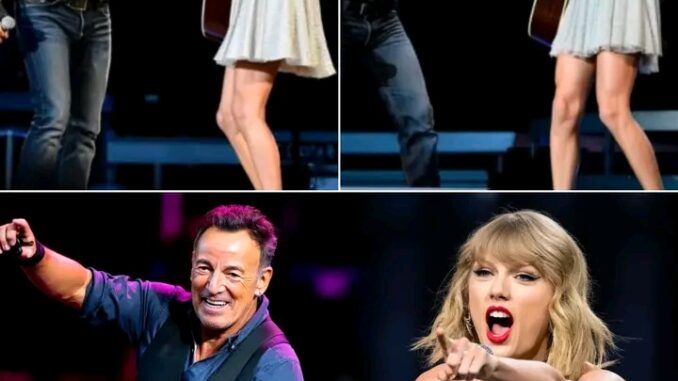
In a historic moment that has sent shockwaves through the music world and beyond, Taylor Swift delivered a powerful message that transcended entertainment, transforming into a rallying cry for change. During her latest concert, Swift boldly declared, “I’m not gonna be quiet about this,” a statement that immediately ignited a firestorm of activism, unity, and artistic rebellion.
The atmosphere was electric as Swift took the stage alongside legendary musician Bruce Springsteen, their collaboration symbolizing a unification of generations and genres. But it was not merely the duet that captured the audience’s attention; it was the palpable sense of defiance and purpose that radiated from both artists. Swift, arm in arm with Springsteen, stood as a beacon of resilience, her stance resonating with millions watching around the world.
From the moment she stepped into the spotlight, the crowd knew they were witnessing more than a musical performance — they were witnessing history in the making. The arena erupted into a chorus of cheers, tears, and chants, as fans and fellow musicians alike recognized the significance of the moment. The stage became a platform not only for song but for solidarity, with “We Stand With You” signs flooding the air, a visual testament to widespread support for causes close to Swift’s and Springsteen’s hearts.
The union of these two icons was complemented by the presence of the U.S. Musicians Union, which took a symbolic stand by aligning themselves with the message of vocal activism. Their participation underscored the importance of standing up for artists’ rights, freedom of expression, and social justice issues that have increasingly become intertwined with the music industry.
The performance was marked by raw emotion and an unyielding call for change. As they performed classic hits infused with renewed purpose, the lyrics took on new meaning — a rallying cry against censorship, silence, and complacency. Swift’s unapologetic stance exemplified a new era where artists are no longer content to stay in the background but are instead using their platforms to advocate for societal progress.
Social media exploded with reactions, with fans and celebrities alike praising the duo’s courage. Hashtags such as #StandWithSwift and #MusicAsResistance trended worldwide, as the performance inspired countless conversations about the role of artists in activism. Many interpreted the moment as a turning point — a reminder that music has always been a catalyst for social change, from the civil rights movement to anti-war protests.
Critics and supporters alike debated the implications of such a bold statement. Some viewed it as a necessary push against the current climate of political and social unrest, while others questioned whether the entertainment industry should be so publicly involved in contentious issues. Nevertheless, the consensus was clear: Swift and Springsteen’s joint act had reignited the power of music as a form of protest and expression.
The full video of the performance, which has since gone viral, captures the electrifying atmosphere and the emotional intensity of the moment. It serves as a reminder that in an era where silence often prevails, some voices refuse to be muted. This event not only exemplifies the influence of popular culture but also underscores the responsibility of artists to speak out on issues that matter.
As the night drew to a close, the message was unmistakable: music can be a force for change, and when artists stand together, their voices can ignite movements. Whether it’s fighting for freedom of speech, advocating for social justice, or simply refusing to stay silent in the face of adversity, this performance will be remembered as a defining moment in contemporary culture.
The collective energy of that night signifies more than just a concert; it marks a shift towards a more outspoken, engaged, and courageous artistic community. As Taylor Swift and Bruce Springsteen demonstrated, when artists refuse to stay quiet, they inspire others to do the same — turning melodies into movements and songs into symbols of resistance.
**FULL VIDEO BELOW
Leave a Reply